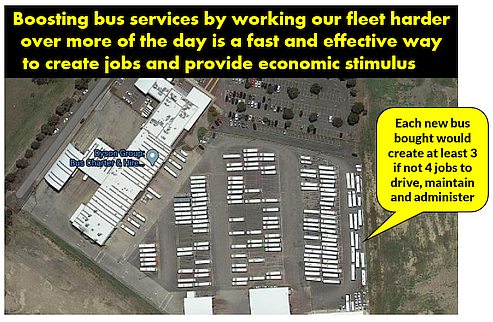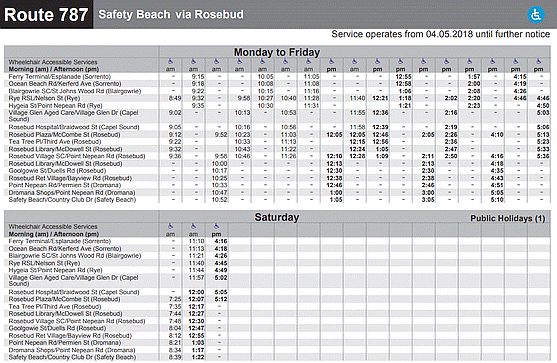Bus 432 doesn't stay on one street for very long. It's your classic 'coverage' neighbourhood bus route designed to connect back streets to shops and stations. Over 30 streets are served in the 45 minutes it takes to get from Yarraville to Newport. The map is below.
Route 432 is possibly best viewed as two routes: Yarraville to Altona Gate and Altona Gate to Newport. No one would ride it from end to end. You can see how it relates to the network generally on the map below.
South Kingsville is the main area where the 432 is the only bus service. In other areas it is near other routes. Notably the 471 in parts of Altona North and Newport.
What's the area like? The 432 serves catchments quite different from one another. The eastern portion (eg South Kingsville and Newport) is an established but gentrifying area with large numbers of CBD workers on good incomes. Altona North, to the west, has newer 1960s-1970s housing. These were better houses than to the east but they were further from transport and services. Many residents worked in manufacturing or at the nearby oil refinery. Average incomes relative to South Kingsville and Newport have fallen as the latter areas gentrified. I wrote much more about all this earlier this month when discussing Route 232 which intersects the 432 at various points.
Patronage
Route 432 is not what you'd call a productive bus route. Infrastructure Victoria reckons that 20 passenger boardings per in-service hour is a threshold for a reasonably productive bus route. Given that local buses travel at 20 km/h or slightly over that equates to one passenger boarding per kilometre.
On normal weekdays Route 432 attracts three-quarters that or 15 boardings per hour. This drops to 12 boardings on school holidays. Saturday is similar at 13 boardings per hour. Sunday however is much lower at 8 boardings per hour.
The tendency for Sunday to be much quieter than Saturday is a characteristic of working class suburbs (especially in Melbourne's middle-west, middle-north and outer south-east) where Sunday is still observed as a day of rest at home. Sundays are much more commercialised in wealthier inner/middle suburbs with many two income households. The same applies for outer coastal, hill and forested areas, especially over summer. Public transport in all these areas can be very well used on Sundays.
Why is Route 432 a poor patronage performer? There's several reasons. The route overlaps with other routes, particular between Newport and Altona Gate. Secondly it's indirect. That makes it less attractive for those who were hoping it would provide a direct trip to the nearest station.
South Kingsville, where the 432 is its only public transport, is the classic example. It is potentially good bus territory for peak commuters as it contains a concentration of CBD workers slightly beyond walking distance of its nearest station at Spotswood. However the 432 in the area goes to Yarraville in a not very direct way. Even the eastern part of Blackshaws Rd, which could have a bus to Newport (suggested here and here), currently lacks a direct service even though one could be introduced for no extra cost with local network reform.
Timetable
Route 432 operates a 7 day service with minimum service standards for local routes. However it has an unusually frequent weekday service for a back-street local bus route.
The 432 is 45 minutes long. The bus operator concerned has long had a timetabling practice where the arrival times at one end are the same as the departure times for the following trip that the bus forms (other bus operators have layover times). Another feature is that scheduled run times are the same whether it is peak or offpeak, weekday or weekend, day or night. That is not necessarily good for timetable adherence though to be fair a lot of the 432 runs on local streets which should be fairly quiet at all times.
If one bus takes 45 minutes each way then a 90 minute headway would be possible with it. Four buses can provide a 22.5 minute headway while two can provide a 45 minute service. The weekday timetable is based on an average 22.5 minute headway. However services are uneven with gaps of 20, 25 and 30 minutes.
This uneven service means that the 432 does not have a user-friendly 'memory timetable'. Nor does it mesh evenly with trains which offer a 10 minute service off-peak. Newport and Yarraville see frequent peak period trains, being served by trains from Werribee, Laverton and Williamstown. The latter two operate every 22 minutes in the peak. Despite 432 being a potential peak feeder route from areas like South Kingsville the uneven service provides longer gaps than would be the case if a uniform 22-23 minute peak headway ran. Particularly in the afternoon this could have simplified commuting with a bus connecting with (say) every Williamstown train. That's different to now where detailed trip planning is required to avoid long waits at Yarraville. The indirect route, not attending to timetable matters like these plus a possibly excessive (but uneven) inter-peak frequency probably all contribute to 432's current poor patronage productivity.
What about weekends? 432's flat 45 minute frequency is operationally efficient. But it does not connect with trains which operate every 20 minutes. As mentioned before Sunday patronage, in particular is very low.
Poor weekend connectivity is common for Yarraville/Newport area bus routes. This is because none, except for Route 471, have had proper service and timetable reviews. Route 431, like 432 operating from Yarraville, particularly springs to mind. Its 30 minute Saturday service operates over limited hours, is poorly used and doesn't harmonise with trains. Sunday service is not provided. A possible way out of this could be to operationally merge it with Route 432 on weekends to enable both to have a 40 minute service on Saturdays and a 40 or 60 minute service on Sundays. This could deliver more even connectivity with trains and better operating hours and days for the 431 for no extra cost.
Route 432 operates in the state seat of Williamstown, held by public transport minister Melissa Horne MP.
History
The 432 as we now know it has not been around forever. Its current form, introduced about 12 years ago, replaced a truly terrible local network with poor access to Altona Gate and inconsistent weekday/Saturday services. It is one of the achievements of the Hobsons Bay/Maribyrnong bus service review which extended the 432 and introduced the Route 431 to replace the existing routes 429 and 430. Old network maps and route histories can be viewed at BCSV, and timetables at Krustylink.
Conclusion
What would you do with the 432? Does it just need a timetable revamp or are route changes also important? Please leave your comments below if you’ve got thoughts. And remember it runs in the seat held by Public Transport Minister Melissa Horne.
An index to all Timetable Tuesday items is here.
An index to all Timetable Tuesday items is here.





























